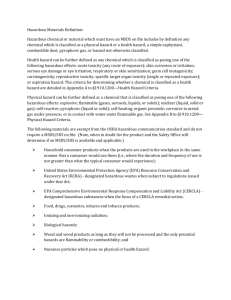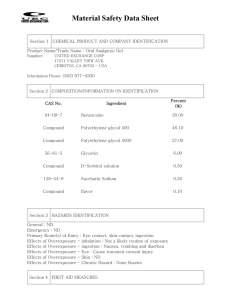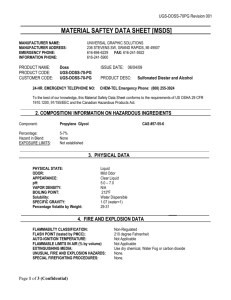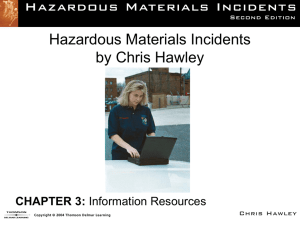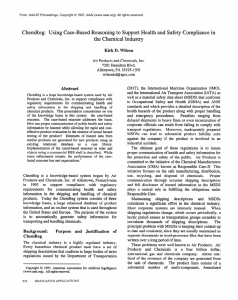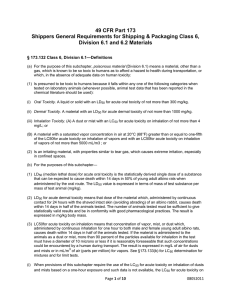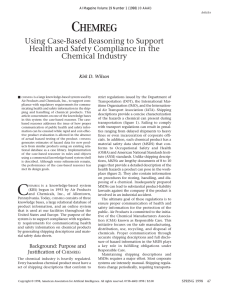What The !@#$%^&* Is A MSDS?
advertisement
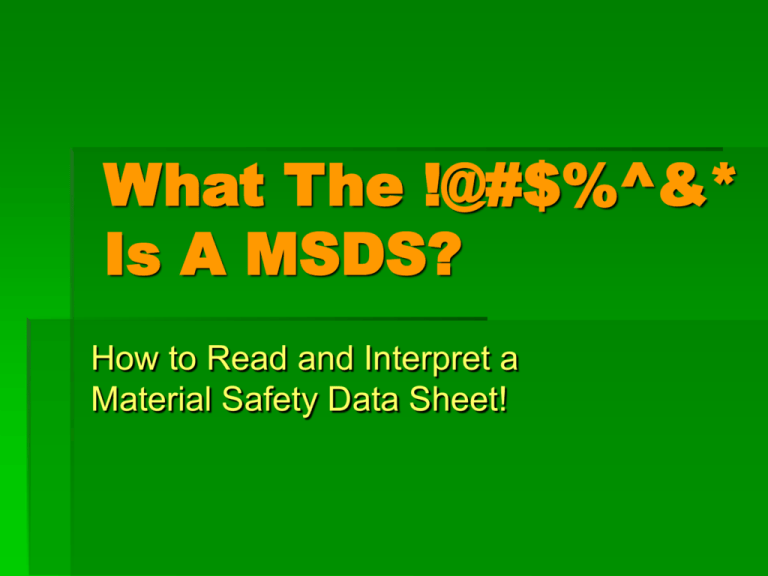
What The !@#$%^&* Is A MSDS? How to Read and Interpret a Material Safety Data Sheet! •Objective to concisely inform you about the hazards of materials you work with so that you can protect yourself and respond to an emergency acts as a “crystal ball” - if you study it, you will see the future •Purpose the material’s physical properties or fastacting health effects that make it dangerous to handle the level of protective gear you need the first aid treatment to be provided when you are exposed to a hazard the preplanning needed for safely handling spills, fires, and day-to-day operations •A Material is Considered Hazardous If- specifically listed in the law, 29CFR Part 1910, Subpart Z, Toxic and Hazardous Substances (the Z list) assigned a Threshold Limit Value (TLV) by the American Conference of Governmental Industrial Hygienists, Inc (ACGIH) determined to be cancer causing, corrosive, toxic, an irritant, a sensitizer, or has damaging effects on specific body organs •The MSDS Format must be in English have a heading cover 16 different informational categories •Heading name and address of the manufacturer telephone numbers transportation emergency number nontransportation information and emergency numbers •Categories of Information 1. Chemical Production Information product name product code chemical family chemical name synonyms formula Chemical Product Information Categories 2. Composition/Information on Ingredients ingredient name CAS number exposure limits concentration (%) names of hazardous ingredients Composition/Information on Ingredients Categories 3. Hazards Identification emergency overview,i.e.,Danger! Toxic potential health effects routes of entry human effects & symptoms of overexposure acute effects of overexposure chronic effects of overexposure carcinogenicity medical conditions aggravated by exposure Hazards Identification Categories 4. First Aid Measures first aid for eyes first aid for skin first aid for inhalation first aid for ingestion note to physician First Aid Measures Categories 5. Fire Fighting Measures flash point flammable limits upper explosive limit (UEL)(%) lower explosive limit (LEL)(%) extinguishing media special fire fighting procedures Fire Fighting Measures Categories 6. Accidental Release Measures spill or leak procedures Categories 7. Handling and Storage storage temperature (min/max) shelf life special sensitivity handling/storage precautions Handling and Storage Categories 8. Personal Protection eye protection requirements skin protection requirements ventilation requirements respirator requirements medical surveillance additional protective measures PPE PPE Categories 9. Physical and Chemical Properties physical form color odor odor threshold molecular weight boiling point melting/freezing point solubility in water specific gravity bulk density % volatile by volume vapor pressure vapor density Physical and Chemical Properties Categories 10. Stability and Reactivity stability hazardous polymerization incompatibilities instability conditions decomposition products Stability and Reactivity Categories 11. Toxicological Information Acute Toxicity oral LD50 dermal LD50 inhalation LC50 eye effects skin effects sensitization Subchronic Toxicity Chronic Toxicity Carcinogenicity Mutagenicity Developmental Toxicity Reproduction Neurotoxicity Toxicological Information Categories 12. Ecological Information 13. Disposal Information Categories 14. Transportation Information technical shipping name freight class package product label DOT (Domestic Surface) proper shipping name UN/UA number packing group DOT product RQ lbs. (kgs) hazard label(s) hazard placard(s) IMO / IMDG Code (Ocean) proper shipping name hazard class division number UN number packing group hazard(s) hazard placard(s) ICAO / IATA (Air) proper shipping name hazard class division number UN number subsidiary risk packing group hazard label(s) radioactivity passenger air - max. qty passenger packing instructions cargo air - max. qty cargo passenger packing instructions Categories 15. Regulatory Information OSHA status TSCA status CERLA Reportable Quantity SARA Title III Section 302 Extremely Hazardous Substances Section 311/312 Hazard Categories Section313 RCRA Status Regulatory Information Categories 16. Other Information NFPA 704M Ratings Reason for Issue Prepared by: Approved by: Title: Approval Date: Supersedes Date MSDA number Other Information Disclaimers no warranties, expressed or implied MSDS is an OSHA document not an EPA document not part of the labeling unless received at the time of purchase READ THE LABEL! Read The Label! UNDERSTAND THE LABEL FOLLOW THE LABEL Their Legacy is the Land. May they Find it as Beautiful and as Bountiful as their Forbearers Did Mary L. Grodner, Ph.D. Pesticide Coordinator LSU AgCenter 225/578-2180 phone 225/578-7829 fax mgrodner@agctr.lsu.edu www.agctr.lsu.edu



